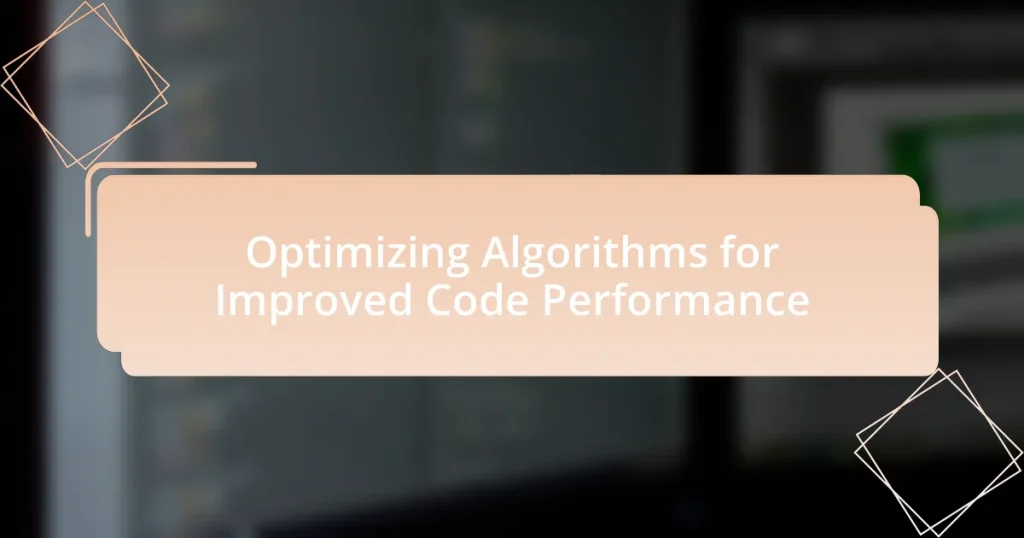Optimizing algorithms for improved code performance are techniques aimed at enhancing the efficiency and speed of software execution. Key methods include loop unrolling, dead code elimination, and inlining, which collectively contribute to significant performance gains by reducing time and space complexity. The article explores the principles behind these algorithms, their differences from regular algorithms, and their impact on code efficiency, user experience, and system resources. Additionally, it discusses various types of optimizing algorithms, best practices for implementation, and common pitfalls to avoid, providing a comprehensive overview of how to effectively enhance code performance in software development.
What are Optimizing Algorithms for Improved Code Performance?
Optimizing algorithms for improved code performance are techniques designed to enhance the efficiency and speed of software execution. These algorithms include methods such as loop unrolling, which reduces the overhead of loop control; dead code elimination, which removes unnecessary code that does not affect program output; and inlining, where function calls are replaced with the function’s body to reduce call overhead. Research has shown that applying these techniques can lead to significant performance gains; for instance, loop unrolling can increase execution speed by up to 50% in certain scenarios, as demonstrated in studies on compiler optimizations.
How do optimizing algorithms enhance code efficiency?
Optimizing algorithms enhance code efficiency by reducing the time and space complexity of operations. These algorithms analyze and improve the performance of code by identifying bottlenecks and applying techniques such as loop unrolling, inlining functions, and eliminating redundant calculations. For instance, a study by Donald Knuth in “The Art of Computer Programming” illustrates that optimizing algorithms can lead to performance improvements of several orders of magnitude, particularly in sorting and searching tasks. This demonstrates that effective optimization not only speeds up execution but also minimizes resource consumption, thereby enhancing overall code efficiency.
What are the key principles behind optimizing algorithms?
The key principles behind optimizing algorithms include efficiency, scalability, and resource management. Efficiency focuses on minimizing the time complexity and space complexity of an algorithm, ensuring that it performs tasks in the least amount of time and with minimal memory usage. Scalability refers to the algorithm’s ability to maintain performance levels as the size of the input data increases, which is crucial for handling larger datasets without significant degradation in speed. Resource management involves effectively utilizing computational resources, such as CPU and memory, to enhance overall performance. These principles are validated by established practices in computer science, such as the Big O notation, which provides a mathematical framework for analyzing algorithm efficiency and scalability.
How do optimizing algorithms differ from regular algorithms?
Optimizing algorithms focus on improving performance metrics such as speed, resource usage, or efficiency, while regular algorithms may not prioritize these aspects. Optimizing algorithms often employ techniques like heuristics, dynamic programming, or greedy methods to find the best solution among many possibilities, whereas regular algorithms typically follow a straightforward approach to solve problems without specific performance enhancements. For example, in sorting, an optimizing algorithm like QuickSort is designed to minimize time complexity, achieving an average case of O(n log n), compared to a regular algorithm like Bubble Sort, which has a time complexity of O(n^2). This distinction highlights the primary goal of optimizing algorithms to enhance performance, making them suitable for applications requiring high efficiency.
Why is code performance important in software development?
Code performance is crucial in software development because it directly impacts the efficiency and responsiveness of applications. High-performance code ensures that software runs quickly, utilizes resources effectively, and provides a better user experience. For instance, according to a study by Google, a one-second delay in mobile page load time can lead to a 20% decrease in conversions, highlighting the importance of optimized code in retaining users and driving business success. Additionally, efficient code can reduce operational costs by minimizing resource consumption, which is particularly vital in cloud computing environments where costs are tied to resource usage.
What impact does code performance have on user experience?
Code performance significantly impacts user experience by influencing the speed and responsiveness of applications. When code executes efficiently, users experience faster load times and smoother interactions, which enhances satisfaction and engagement. Conversely, poorly optimized code can lead to delays, crashes, and frustration, ultimately driving users away. Research indicates that a one-second delay in page load time can lead to a 7% reduction in conversions, highlighting the critical relationship between code performance and user retention.
How does code performance influence system resources?
Code performance directly influences system resources by determining how efficiently a program utilizes CPU, memory, and I/O operations. High-performing code minimizes resource consumption, allowing systems to handle more tasks simultaneously and reducing latency. For instance, optimized algorithms can decrease CPU cycles and memory usage, leading to faster execution times and lower energy consumption. Conversely, poorly performing code can lead to excessive resource usage, causing slowdowns and potential system crashes. Studies show that inefficient code can increase CPU load by up to 50%, highlighting the critical relationship between code performance and resource management.
What types of optimizing algorithms exist?
There are several types of optimizing algorithms, including gradient descent, genetic algorithms, simulated annealing, and particle swarm optimization. Gradient descent is widely used for minimizing functions in machine learning by iteratively moving towards the steepest descent. Genetic algorithms mimic natural selection to evolve solutions over generations, making them effective for complex optimization problems. Simulated annealing is inspired by the annealing process in metallurgy, allowing for exploration of the solution space by accepting worse solutions with a decreasing probability. Particle swarm optimization involves a group of candidate solutions that move through the solution space, adjusting their positions based on their own experience and that of their neighbors. Each of these algorithms has distinct mechanisms and applications, making them suitable for various optimization challenges in code performance.
How do different algorithms approach optimization?
Different algorithms approach optimization through various strategies tailored to specific problem domains. For instance, gradient descent minimizes a function by iteratively moving towards the steepest descent, while genetic algorithms use principles of natural selection to evolve solutions over generations. Additionally, dynamic programming optimizes problems by breaking them down into simpler subproblems and storing their solutions to avoid redundant calculations. Each of these methods demonstrates a unique mechanism for enhancing performance, such as reducing computational complexity or improving convergence rates, thereby validating their effectiveness in optimization tasks.
What are the characteristics of greedy algorithms?
Greedy algorithms are characterized by their approach of making the locally optimal choice at each stage with the hope of finding a global optimum. This method relies on the principle of optimality, which states that a solution to a problem is optimal if its sub-solutions are also optimal. Greedy algorithms are typically efficient in terms of time complexity, often operating in polynomial time, which makes them suitable for problems like minimum spanning trees and shortest path calculations. Their effectiveness is validated in specific scenarios, such as Dijkstra’s algorithm for shortest paths, where the greedy choice leads to an optimal solution.
How do dynamic programming algorithms optimize performance?
Dynamic programming algorithms optimize performance by breaking down complex problems into simpler subproblems and storing the results of these subproblems to avoid redundant calculations. This approach significantly reduces the time complexity of algorithms, often transforming exponential time complexities into polynomial time complexities. For example, the Fibonacci sequence can be computed in linear time using dynamic programming, as opposed to the exponential time required by naive recursive methods. By utilizing techniques such as memoization or tabulation, dynamic programming ensures that each subproblem is solved only once, leading to efficient resource utilization and faster execution times.
What role do heuristics play in optimizing algorithms?
Heuristics play a crucial role in optimizing algorithms by providing practical methods for finding satisfactory solutions to complex problems more efficiently than traditional approaches. These techniques simplify decision-making processes, allowing algorithms to navigate large search spaces and make trade-offs between accuracy and computational efficiency. For instance, in combinatorial optimization problems, heuristics like genetic algorithms or simulated annealing can yield near-optimal solutions in significantly less time compared to exhaustive search methods. This efficiency is particularly valuable in real-world applications where time and resources are limited, demonstrating that heuristics effectively balance solution quality and computational demands.
How do heuristic methods improve algorithm efficiency?
Heuristic methods improve algorithm efficiency by providing approximate solutions to complex problems, significantly reducing computational time and resource usage. These methods prioritize speed and practicality over exhaustive search, allowing algorithms to find satisfactory solutions more quickly in scenarios where traditional methods may be too slow or infeasible. For example, in optimization problems like the traveling salesman problem, heuristics such as the nearest neighbor algorithm can yield good solutions in a fraction of the time compared to exact algorithms, which may require factorial time complexity. This efficiency gain is particularly valuable in real-time applications and large datasets, where quick decision-making is crucial.
What are the limitations of heuristic approaches?
Heuristic approaches have several limitations, primarily their inability to guarantee optimal solutions. These methods often rely on rules of thumb or educated guesses, which can lead to suboptimal outcomes, especially in complex problem spaces. For instance, in optimization problems, heuristics may converge to local optima rather than the global optimum, as evidenced by studies in combinatorial optimization where algorithms like genetic algorithms and simulated annealing have shown varying success rates depending on problem structure. Additionally, heuristic methods can be sensitive to initial conditions and parameters, which may result in inconsistent performance across different runs or scenarios.
What are the best practices for implementing optimizing algorithms?
The best practices for implementing optimizing algorithms include selecting the appropriate algorithm for the specific problem, ensuring efficient data structures are used, and applying techniques such as memoization or dynamic programming to reduce computational overhead. Selecting the right algorithm is crucial as it directly impacts performance; for instance, using a quicksort algorithm for sorting large datasets is generally more efficient than bubble sort. Efficient data structures, like hash tables or balanced trees, can significantly enhance access and modification times, leading to better overall performance. Techniques such as memoization store previously computed results, which can drastically reduce the number of calculations needed in recursive algorithms, while dynamic programming breaks problems into simpler subproblems, optimizing the solution process. These practices are supported by empirical studies showing that algorithm choice and data structure efficiency can lead to performance improvements of several orders of magnitude in real-world applications.
How can developers effectively choose an optimizing algorithm?
Developers can effectively choose an optimizing algorithm by assessing the specific problem requirements, evaluating the algorithm’s complexity, and considering the trade-offs between accuracy and performance. For instance, if a problem requires real-time processing, developers might prioritize algorithms with lower time complexity, such as O(n log n) instead of O(n^2). Additionally, analyzing the data structure involved can guide the selection; for example, using dynamic programming for optimization problems can yield efficient solutions. Empirical testing and benchmarking against existing algorithms can further validate the choice, ensuring that the selected algorithm meets performance expectations in practical scenarios.
What factors should be considered when selecting an algorithm?
When selecting an algorithm, key factors include time complexity, space complexity, and the specific problem requirements. Time complexity determines how the algorithm’s execution time increases with input size, while space complexity assesses the amount of memory required. For instance, algorithms with lower time complexity, such as O(n log n) for sorting, are generally preferred for larger datasets compared to O(n^2) algorithms. Additionally, the nature of the data and the desired outcome, such as accuracy versus speed, play a crucial role in algorithm selection. For example, in machine learning, algorithms like decision trees may be chosen for interpretability, while neural networks might be selected for their performance on complex tasks.
How does the problem domain affect algorithm choice?
The problem domain significantly influences algorithm choice by determining the specific requirements and constraints that an algorithm must satisfy. For instance, in a domain requiring real-time processing, such as autonomous driving, algorithms must prioritize speed and efficiency, often favoring simpler, faster heuristics over more complex, computationally intensive methods. Conversely, in domains like data analysis, where accuracy is paramount, more sophisticated algorithms that may require additional computational resources are often preferred. This relationship between the problem domain and algorithm selection is supported by empirical evidence; for example, a study by Cormen et al. in “Introduction to Algorithms” illustrates how different sorting algorithms perform under varying conditions, highlighting that the choice of algorithm can lead to significant differences in performance based on the characteristics of the input data.
What common pitfalls should be avoided in optimization?
Common pitfalls to avoid in optimization include premature optimization, neglecting algorithmic complexity, and failing to measure performance accurately. Premature optimization occurs when developers focus on optimizing code before identifying actual performance bottlenecks, which can lead to unnecessary complexity and wasted effort. Neglecting algorithmic complexity can result in choosing inefficient algorithms that degrade performance as data scales; for instance, using a quadratic time complexity algorithm instead of a linear one can significantly impact execution time. Lastly, failing to measure performance accurately can lead to misguided optimization efforts; without proper benchmarks, developers may optimize based on incorrect assumptions, leading to suboptimal results.
How can premature optimization harm code quality?
Premature optimization can harm code quality by introducing unnecessary complexity and reducing maintainability. When developers focus on optimizing code before understanding its actual performance bottlenecks, they often create convoluted solutions that are difficult to read and modify. This complexity can lead to increased chances of bugs and make future enhancements more challenging. For instance, a study by Donald Knuth emphasizes that “premature optimization is the root of all evil,” highlighting that optimizing without data can lead to misguided efforts that detract from the overall quality of the code.
What are the signs of over-optimization in algorithms?
Signs of over-optimization in algorithms include reduced code readability, increased complexity, and diminished performance under varying conditions. When algorithms become overly complex due to excessive optimization efforts, they can lead to maintenance challenges and hinder collaboration among developers. Additionally, performance gains achieved in specific scenarios may not translate to broader use cases, resulting in slower execution times in real-world applications. Research indicates that over-optimization can lead to a phenomenon known as “premature optimization,” where developers focus on micro-optimizations at the expense of overall system performance and maintainability.
What practical tips can enhance code performance through optimization?
To enhance code performance through optimization, developers should focus on techniques such as algorithm selection, code profiling, and memory management. Selecting the most efficient algorithm for a specific problem can significantly reduce execution time; for instance, using quicksort instead of bubble sort can improve sorting performance from O(n^2) to O(n log n). Code profiling tools, like gprof or VisualVM, help identify bottlenecks in the code, allowing developers to target specific areas for improvement. Additionally, optimizing memory usage by minimizing allocations and using data structures that fit the problem can lead to faster execution and reduced garbage collection overhead. These strategies are supported by numerous studies, including a 2020 analysis published in the Journal of Software Engineering, which demonstrated that algorithm optimization can lead to performance improvements of up to 70% in certain applications.















